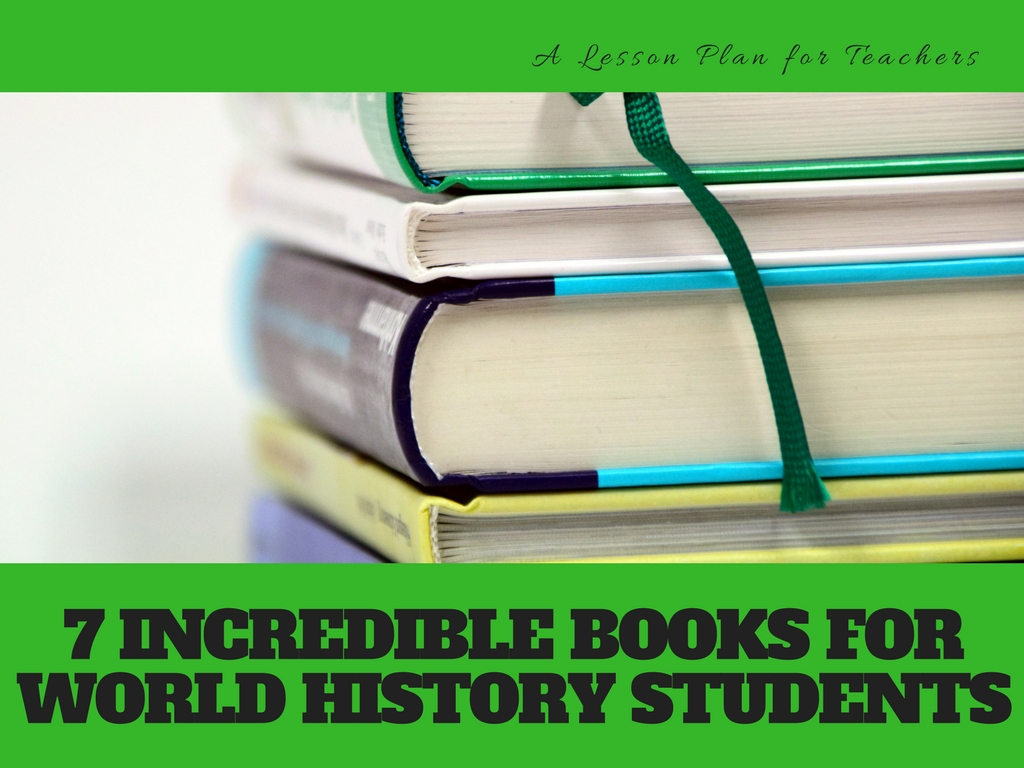of teaching World History is watching your students transform from
observers of history to historians. World History offers a unique
perspective on history and social studies as a whole; culturally-diverse
viewpoints, experiences, and lesson plans present a new piece to the
puzzle. From the Renaissance to world religions, cultural differences to
comparisons between countries, teaching World History to your students can
ignite an interest in the world around them.

Teaching
World History doesn’t have to come strictly from a textbook. In fact,
presenting different worldviews and cultural ideas will spur an interest in
your students that mundane textbooks may not. While many World History books
exist, the following 7 incredible books to read with World History students
will provide a solid foundation for integrating culture and diversity into
your World History lesson plans. Incorporate these texts into your World
History lesson plans and encourage your students to embrace the cultural
differences wholeheartedly. You’ll watch not only their minds transform, but
also their hearts.
1. Life in a Medieval City
– This book, by Frances Gies and Joseph Gies, contrasts factual Middle
Age history with a delicate balance of realistic biographical text,
entertaining writing styles, and engaging historical perspectives.
Discussing French history before the Black Plague, Gies and Gies explore
a time before modern conveniences, and what life would have been like
in a city circa the Middle Ages.
BONUS! Pair this read with a Middle Ages Daily Life Activity which explores Middle Ages topics including clothing, food, entertainment, weapons, the Bubonic Plague, and more!
2. 1066: The Year of the Conquest
– David Halwarth’s 1066: The Year of the Conquest describes the time
surrounding William the Conqueror’s defeat of the English at the Battle
of Hastings. Using a plethora of sources, Halwarth examines conflicting
perspectives on commoners, kings, and who actually won the battle.
3. The
Last Voyage of Columbus: Being the Epic Tale of the Great Captain’s
Fourth Expedition, Including Accounts of Mutiny, Shipwreck, and
Discovery – Written by Martin Dugard, The Last Voyage of Columbus
explores the Age of Exploration from a biographical perspective. Dugard
writes through the eyes of Christopher Columbus as he retells his life
in the year 1500 and the events that followed his discovery of the New
World.
BONUS! After reading The Last Voyage, analyze The Washington Post’s Five Myths About Christopher Columbus. Were these myths discussed in the book? Solicit reactions from students.
4. Into Africa: The Epic Adventures of Stanley and Livingstone
– Martin Dugard tells the viewpoints of both Dr. David Livingstone and a
journalist, Morton Stanley, as they embarked upon the exploration of
Africa. Discussing all aspects of the exploration, from politics to
personal encounters to the good and bad of their journeys, Into Africa
discusses African exploration with a very intimate feel.
5. Genghis Khan and the Making of the Modern World
– Jack Weatherford, author of Genghis Khan and the Making of the Modern
World, recounts the Middle Ages and exploration in Asia during and
after the time of Genghis Khan. Examining his leadership on a profound level, Weatherford introduces Khan to readers while seamlessly
incorporating the history of the times.
BONUS! Create a Venn Diagram after comparing Genghis Khan and the Making of the Modern World to a History Stories article, 10 Things You May Not Know About Genghis Khan. What similarities did you find? Differences?
6. Guns, Germs & Steel
– Guns, Germs and Steel: The Fates of Human Societies, by Jared
Diamond, Ph.D., recounts tales of exploration and industrialization
while boasting the human condition that influenced our modern world. He
brings a scientific viewpoint to the table while also examining culture
and society and how they were impacted by their environment, their early
food production, religion, and more.
7. The Things They Carried
– In The Things They Carried, Tim O’Brien examines war, but also
integrates perspectives on the soldier’s innermost thoughts and
circumstances, viewpoints from the surrounding world, and delves into
truth in storytelling. Renowned by the Chicago Sun as “…controlled and
wild, deep and tough, perceptive and shrewd,” The Things They Carried
brings an emotional aspect into an otherwise chilling account of war.
BONUS
READ! Don’t dismiss the idea of reading a picture book to or with your
World History students. Sometimes, reading a simpler, aesthetically-pleasing
children’s book can enhance your student’s understanding of an otherwise
hard-to-grasp or emotionally-trying topic. Faithful Elephants: A True Story of Animals, People, and War
takes its readers along for the ride with three elephants at a Tokyo Zoo
who are influenced greatly by World War II going on around them.
SUPER BONUS! Once students have examined WWII from an emotionally engaging children’s perspective, use the WWII Infographic Analysis Interactive Lesson to provide an intellectual perspective on the war.
 World History textbooks are sometimes stereotyped as one-sided, biased, or otherwise ineffective at presenting the whole picture. Studying World History
World History textbooks are sometimes stereotyped as one-sided, biased, or otherwise ineffective at presenting the whole picture. Studying World History
through a different lens, with the use of many external resources, will
allow you to present both an emotional perspective which will capture
your students and spur an interest in the topic, as well as a more
clinical and historically-accurate perspective, which ensures that your
World History students will grasp the knowledge needed for AP Testing, standardized testing, further Social Studies education, and college or higher level education. Engage students with a World Religions Comparison Activity, or sit down with a children’s book to absorb the emotions surrounding war, poverty, and conflict. Presenting World History lessons in a diverse and engaging manner will incite a love for learning World History among your students.
Happy Teaching!
